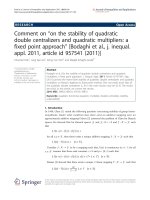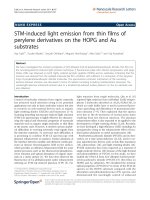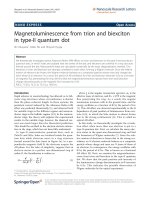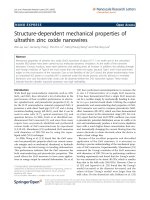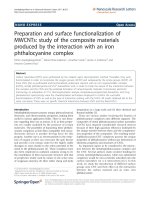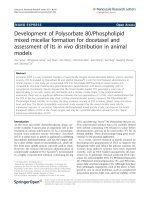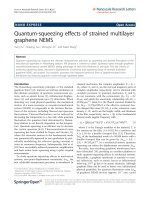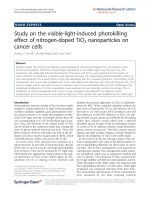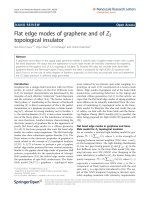von der Schulenburg et al. Health Economics Review 2011, 1:18 doc
Bạn đang xem bản rút gọn của tài liệu. Xem và tải ngay bản đầy đủ của tài liệu tại đây (220.59 KB, 8 trang )
RESEARCH Open Access
The effects of drug market regulation on
pharmaceutical prices in Europe: overview and
evidence from the market of ACE inhibitors
Fritz von der Schulenburg
1,2
, Sotiris Vandoros
1
and Panos Kanavos
1*
Abstract
This study provides an overview of policy measures targeting pharmaceutical expenditure in Europe and analyses
their impact on originator pharmaceutical prices. Panel data methods are used to examine the market of ACE
Inhibitors in six European countries (Denmark, France, Germany, Netherlands, Sweden, United Kingdom) over period
1991-2006. We find that although some measures are effective in reducing originator prices, others appear to have
an insignificant effect. Results suggest that supply side measures such as mandatory generic substitution, regressive
pharmacy mark-ups and claw-backs are effective in reducing pharmaceuticals prices. Results are not as strong for
demand side measures. Profit controls and the use of cost-effectiveness analysis appear to have a negative effect on
prices, while results on reference pricing are inconclusive. Findings also indicate that, although originator prices are
not immediately affected by generic entry, they may be influenced by changes in generic prices post patent expiry.
Keywords: Regulation, Pharmaceuticals, Panel Data, Europe
1. Background
1.1 Introduction
The special nature of pharmaceutical markets (due to
patent protection, third-party payers and low pri ce elasti-
city) has led to the introduction of regulation in European
markets. A variety of policy measures have been imple-
mented in the European Union in order to control phar-
maceutical prices. These measures differ significantly
across countries, but have a common goal of efficient dis-
pensing and keeping prices at reasonable levels, while ele-
ments of industrial policy can be found in some countries.
Regulatory measures target both the demand side, as well
as the supply side. However, although the aim of regula-
tion is usually to decrease costs, it is not always the case
that regulatory measures have the desired effect on prices
and sales volume, because of market distortions.
Pharmaceutical market dyn amics vary across Europe
due to different regulatory frameworks. Empirical evi-
dence has shown that heavily regulated markets with low
prices tend to have fewer branded and generic launches
than unregulated markets and demonstrate longer launch
delays [1], while generic entry is less likely to occur in
low-price economies and in countries with less regulation
[2]. It has been shown that firms launch earlier in high-
price EU countries [3]. There is evidence that firms
launch strategically due to the direct influence of existing
prices for the same drug in other countries. Empirical
research comparing major EU countries with the US and
Canada suggests that most European countries, which
tend to be more regulated than the US, show a relatively
higher presence of generic entrants [4].
The literature on the impact of generic entry on origi-
nator prices in Europe is inconclusive. However, empiri-
cal evidence from the US and other markets suggests
that generic entry can lead to an increase in branded
prices [5-8]. This phenomenon is known as the “generic
paradox”. The number of generic competitors might have
an infl uence on th e ge neral price level via other factors
[9,10]. However , it has been shown that originator prices
do not increase post patent expiry [11]. Anot her study
suggests that in the US, generic entry does not lead to a
decrease in originator prices, but further price growth is
“muted” [12]. In addition, th e number of branded substi-
tutes appears to have a negative effect on launch prices
* Correspondence:
1
LSE Health London School of Economics, Houghton Street London WC2A,
UK
Full list of author information is available at the end of the article
von der Schulenburg et al . Health Economics Review 2011, 1:18
/>© 2011 von der Schulenburg e t al; licensee Springer. This is an Open Access article distributed under the terms of the Creative
Commons Attribut ion License (http://creat ivecommons.org/licens es/by/2.0), which permits unrestricted use, distri bution, and
reproduction in any medium, provided the original work is properly cited.
of new products [13,14]. There is evidence that generic
prices decrease over time, which indicates the presence
of generic competition among generic products in addi-
tion to some level of perceived product differentiat ion
compared to branded pharmaceuticals. The market share
of generics for certain products usually becomes quite
large in short periods in most countries. After one year
of entry, generic pharma ceuticals achieved a 44% market
share in the US market [7,9].
With regards to reference pricing, it has been suggested
that this policy has a marginally negative impact on
prices [4]. Also, previous studies have analysed a change
in Norway in 1993 from a price cap system to a reference
based pricing system and its influence on pharmaceutical
prices [15,16]. Findings showed that the reform led to
loweroriginatorandgenericprices within the reference
groups and an increase in generic market shares. How-
ever, it should be noted that these results do not necessa-
rily imply that the decline would have been smaller if
there had been no market intervention at all [17]. A
study on Germany found that savings accumulated from
implementing reference pricing were equal to nine per-
cent of to tal drug expenditure [18]. Another policy inter-
vention is tendering, which has been introduced in the
market of some molecules in the Netherlands and Ger-
many. Prices in the Netherlands decreased up to 92% as a
result of tendering [19]. Evidence from Germany suggests
that reference pricing and tendering have ‘additive effects’
[20]. Finally, an i nteresting study on supply-side mea-
sures has concluded that regulation may hurt competi-
tion between branded drugs [21].
In order t o maximise the effectiveness of supply-side
measures, appropriate demand-side measures are neces-
sary [22,23], combined with other volume control mea-
sures [24,25]. Dema nd-side regulations and incentives
can aim at physician prescribing behaviour or pharmacy
dispensing patterns [17], which may include financial or
non-financial incentives [26]. Empirical evidence has
shown that regulatory policies t hat encourage or oblige
pharmacists to substitute branded pharmaceuticals lead
to a significant increase in the market share of the substi-
tutes [27]. Other demand-side measur es such as regres-
sive pharmaceutical margins and policies targeting
physicians’ prescribing behaviour (e.g. budgets) have a
positive impact on generic market shares [28]. Alt hough
results of another study were quite similar, a natural
experiment showed that the number of hospital admis-
sions and referrals increased significantly after Germany’s
introduction of pharmaceutical budgets in 1994 [29].
1.2. Drug Market Regulation in EU countries
In this paper we s tudy six countries (UK, Germany,
France, Denmark, Netherlands and Sweden) in order to
gain insight into the effects of various regulatory measures
on originator and generic prices. T he selection of the
countries is based on two primary criteria. We have
selected large and widely referenced markets like
Germany, France and the UK. In addition we have chosen
countries with an interesting policy mix, such as the Neth-
erlands, Sweden, Denmark. G ermany (which is the t hird
largest pharmaceutical market i n the world) provides an
interesting combination of free pricing for in-patent drugs
and reference pricing for off-patent drugs. The United
Kingdom is also a large market and is known for its
unique indirect price regulation via rate-of-return regula-
tion (profit controls) and for explicitly tackling t he
demand-side through a mix of regulatory measures such
as claw-backs and incentives (e.g. pres cribing guidelines,
monitoring and budgets). France has the highest health
care expenditure relative to the GDP in the EU and is the
third largest drug producer in the world, accounting for
7% of the world’s pharmaceutical output. In the Nether-
lands, the use of health technology assessment is used for
new drugs, while reference pricing ap plies in off-pa tent
markets (a relatively recent development i s the introduc-
tion of tendering for the procurement of a limited number
of out-patient drugs. The same applies in Germany). Phy-
sician and pharmacist incentives also play an important
role in the Netherlands. Sweden was included because
reforms that have taken place in this country since 2002
provide an interesting case for the empirical analysis. Sev-
eral reforms have also been introduced in Denmark over
the past decade. By including these six selected countries,
the empirical analysis offers insight into different regula-
tory environments. Table 1 provides an overview of policy
options in regulated pharmaceutical markets and Table 2
provides an overview of regulatory policies implemented
in each of the study countries.
Supply-side measures
A popular pricing policy, which is extensively used in
Europe (Germany, Denmark, France, Sweden, Nether-
lands), is reference pricing. The reference price defines a
reimbursement rate or level for all products within a spe-
cific group of drugs. The reference price reflects what is
reimbursed by health insurance. If a product’ sprice
exceeds the reference price, the product may no t be cov-
ered, or the patient ma y have to pay the diff erence out-
of-pocket. The reference price may be set at the molecule
level (thus applying to off-patent markets) or the thera-
peu tic class level, in wh ich case prices of in- patent drugs
in the same class may also be subject to the reference
price.
The use of evaluation methods to suppor t r eimburse-
ment deci sions is bec oming increasingly popular in the
EU. The use of cost-effectiveness analysis (and health tech-
nology assessment in general) influences the suppliers’ pri-
cing decisions, as setting a relatively high price (compared
to therapeutic value) may have a negative impact on the
von der Schulenburg et al . Health Economics Review 2011, 1:18
/>Page 2 of 8
decision of whether the product will be reimbursed or not.
Cost-effectiveness analysis is a valuable tool in deciding
upon whether to have a product reimbursed or not.
Another way to regulate prices is through price controls.
The launch price m ight depend on clinical performance,
economic evaluation, costs of already existing similar
treatments, the basis of calculation (e.g., average, lowest
price), costs plus a certain profit margin or on interna-
tional and national prices of the same product [30]. In
some cases drugs can be freely priced.
Instead of directly interfering in pricing strategies of
companies, rate-of-return regulation can mark a profit
limit (as in the UK). Thi s type of regulation is implemen-
ted in order to achieve reasonable prices while safeguard-
ing the profitability of the innovative pharmaceutical
industry. Another possibility is to give tax benefits for
investments in R&D or in manufacturing capacity [30].
Various types of volume controls are also used in t he
EU. Such controls are used because price controls are
often ineffective in controlling pharmaceutical expenditure
due to ris ing utilization. Price-volume agreements can be
reached through negotiations between the industry and
authorities. Producers that ex ceed the agreed volume are
penalized and obliged to decrease the price or pay back a
certain amount or return a certain amount of their rev-
enue to the purchaser . Paybacks are often used as thread
methods for price-volume agreements. Price cuts also
apply across the EU. Finally, rebates include any returns
on sales made by a manufacturer to an institutional player
[30].
Demand-side measures
Drug consumption can be influenced and regulated
through different monetary incentives, regulation,
schooling and exchange of information. Physicians act
as patients’ age nts and express proxy demand, as they
have more information about appropriate treatments
than patients. Financial or non-financial incentives can
be used to help physicians prescribe in a cost-effective
way.
Efficient prescribing and the minimisation of risk for
patients can be supported and upgraded by educational
barriers (classification for physicians) and information
methods. Computerized decision support, o nline pre-
scribing advice and prescribing monitoring can help
achieve improved prescribing patterns. Another way of
influencing prescribing is through the implementation
Table 1 Overview on regulation on the supply- and
demand-side
Supply-side Demand-side
Price Controls Physicians
Based on: Clinical practice
Clinical performance Prescription guidelines
Economic performance Education
Cost of existing treatments Information
Cost-plus calculations Monitoring/audit
International prices Prescription quotas
Controlled price update Pharmaceutical budgeting
Free Pricing Overall budgets
Expenditure Control Patients
Discounts Cost sharing
Rebates Information
Pay-back Education
Price-volume agreements OTC spending
Price freeze/price cuts
Pharmacies
Industrial Regulation Generic substitution
Profit controls/Rate of return Monetary incentives
Tax benefits Claw-backs
Margins
Discounts
Table 2 Pharmaceutical Policies in six European countries
Sweden Netherlands Denmark France UK Germany
Reference Pricing X (since
1993)
X X (since 1993) X (since 2003) X
Substitution Mandatory X (since
2002)
X (since 1997) X (since
2004)
Generics Price Control X X (since
2000)
Mark-up Regression X X (until 2007) X (with a pause between
1999-2003)
X X (since
2003)
Profit Control X
Clawback X (since
1998)
X (since
1997)
X (since
2004)
Tax Funded Health Care
System
XX X
Cost-Efficiency Analysis X (since
2002)
X (since
1998)
X (since 2005, but not
compulsory)
X (since
2000)
von der Schulenburg et al . Health Economics Review 2011, 1:18
/>Page 3 of 8
of prescription quotas and pharmaceutica l budgets.
These motivate physicians to be cost-conscious when it
comes to selecting between alternative treatments. Pre-
scribing by INN rather than b y brand name and dispen-
sing policies at the pharmacy level can also encourage
efficient use of medicines. Generic substitution at the
pharmacy encourages or obliges physicians to dispense
generics instead of the corresponding originators. This
helps increase generic market shares, cost-effectiveness
and encourage generic entry. Furthermore, claw-backs
are used by authorities to gain back part of the dis-
counts that pharmacists receive on generic products.
Healthcare authorities also implement monetary incen-
tives for pharmacists through mark-up schemes. Carefully
designed regressive pharmacy margins make dispensing
cheaper products mo re profitable for pharmac ists, hence
encour aging them to dispense generics rather than origi-
nators. A flat fee per prescription would normally not give
any incentive to dispense cheaper or more expensive pro-
ducts. However, as pharmacists often receive discounts on
genericproducts,aflatfeewouldprobablyalsomake
them prefer generics to originators.
Patients also play a role in the pharmaceutical market,
although this is limited because physicians usually express
demand for drugs on their behalf. Due to high reimburse-
ment level s in most EU countries, cost-consciousness is
often low. Patient behaviour can be influenced by fees and
cost sharing. Cost-sharing, which is the most common way
of affecting patients, is used in many countries in different
ways. Cost sharing might, for example, be set as a fixed co-
payment for drugs (per item, per packet etc.) or a fixed fee
paid to pharmacists. Thes e payments may also be a variable
percentage of the prescribed drug’sprice.Anotherpossibi-
lity of affecting patients’ behaviour lies in informational
and educational campaigns. This might increase their
awareness regarding differen t ial co-paymen ts, gen eric bi oe-
quivalence an d r ationa l u se of pharmaceuticals.
Using an empirical investigation, the paper studies the
impact that regulation has on pharmaceuti cal prices, and
the effect of generic competition on market dynamics in
six pharmaceutical markets in Europe (UK, Germany, the
Netherlands, France, Denmark, Sweden) post patent
expiry. The paper is organised as follows: Section 2
explains the methodology employed; section 3 provides
the empirical results; section 4 provides a discussion and
policy implications; section 5 concludes.
2. Methods
After having explained the vari ous regulatory regimes in
the six European countries considered in this study, we
proceed to study the actual effects of the discussed regu-
latory measures on drug prices.
Pharmaceutical prices depend on patent protection,
market structure and regulation. The presence of patent
protection defines the market as a monopoly for a parti-
cular molecule. Post-patent expiry generics competitors
are present, so the market of the particular molecule is
no longer a monopoly, indicating that markets change
significantly over a product’s life cycle . Regula tory mea -
sures are implemented by authorities in order to prevent
pharmaceutical prices from being very high and to enable
access to medicines for eligible patients. S uch measures
heavily affect prices an d market sha res, so price s are
expected to evolve differently depending on the level and
thenatureofregulation.Theempiricalmodelthatwe
estimate in this section is based on these market
dynamics.
According to economic theory and the nature of policies
and other aspects of the pharmaceutical market, we have
expectations with regards to the direction of their impact
on prices. The number of competitors in the market is
expected to have a negative impact on prices. The same
applies to the presence of generic competitors, as generic
entry means that competition in the market of the particu-
lar molecule is now present. Generic prices are expected
to be positively associated with originator prices, as gener-
ics and originators of the same molecule are direct
substitutes.
The goal of reference pricing is to keep prices at moder-
ate lev els, as in the presence of this policy the cheape st
product gets reimbursed, creating an incentive for produ-
cers to reduce their price. Therefore, we expect this policy
measure to have a negative effect on prices. Product sub-
stitution at the ph armacy and regressive mark-ups would
normally also be expected to create downward pressure
on prices, as the manufact urer of the product would
decrease the price in order to have the product dispensed:
A lower price could prevent generic substitution, while
regressive mark-ups would often make pharmacists dis-
pense cheaper products, therefore the manufacturer would
decrease the price in order to have their product dis-
pensed. Profit controls are not necessarily expected to
decrease prices, as their goal is not only to provide afford-
able medicines, but also to ensure the presence of a viable
pharmaceutical industry.
Data on ACE Inhibitors are used for the empirical analy-
sis. The reason these drugs are used is because they belong
to a high-volume class for a common disease (cardiovascu-
lar disease). Further, off-patent ACE Inhibitors face exten-
sive generic competition due to the relatively high volume
of ACE Inhibitor sales in the EU. Data on ACE Inhibitor
prices were obtained from the IMS Midas database. These
include actual public prices, deflated and converted to
Euros. Data are reported quarterly, from 1991 to 2006.
The sample include s all available ACE Inhibitors (capto-
pril, enalapril, lisinopril, quinapril, ramipril, trandalopril,
periodinopril, moexipril, fisinopril, benazepril, cilazapril,
zofenopril, imidrapril, apriapril). Six countries were
von der Schulenburg et al . Health Economics Review 2011, 1:18
/>Page 4 of 8
considered for the purpose of the analysis (Denmark,
France, German y, Netherlands, S weden and the United
Kingdom). Including different countries in the sample
allows us to control for different regulatory regimes across
markets and unobserved heterogeneity.
We create models in order to empiric ally test the
impact of regulation on originator and generic prices
(Equations (1), (2), (3) and (4)). These show the impact
of market structure and policies on originator prices.
The coefficients re veal whether each of the variables has
a positive or negative impact on originator prices and
whether their effect is statistically significant or not.
price
it
= α + β
0
+ β
1
generics
it
+ β
2
rp
it
+ β
3
sm
it
+ β
4
mark
it
+ β
5
profitc
it
+ β
6
clawback
it
+ β
7
tax
it
+ β
8
cea
it
+ ε
it
(1)
price
it
= α + β
0
+ β
1
n
it
+ β
2
rp
it
+ β
3
sm
it
+ β
4
mark
it
+ β
5
profitc
it
+ β
6
clawback
it
+ β
7
tax
it
+ β
8
cea
it
+ v
it
(2)
price
it
= α + β
0
+ β
1
genprice
it
+ β
2
rp
it
+ β
3
sm
it
+ β
4
mark
it
+ β
5
profitc
it
+ β
6
clawback
it
+ β
7
tax
it
+ β
8
cea
it
+ u
it
(3)
price
it
= α + β
0
+ β
1
genprice
it
+ β
2
n
it
+ β
3
rp
it
+ β
4
sm
it
+ β
5
mark
it
+ β
6
profitc
it
+ β
7
clawback
it
+ β
8
tax
it
+ β
9
cea
it
+ μ
it
(4)
price is the price of the originator product, measured
in logs. generics is a dummy variable. It is 1 if generic
competitors are present and zero otherwise. genprice is
the price of the generic product. n indicates the number
of generic competitors in the market of a particular
molecule. It is zero when there are no generics in the
market. rf is a policy dummy variable indicating the pre-
sence of reference pricing. sm is also a dummy variable
indicating the presence or not of mandatory generic
substitution at the pharmacy level. mark indicates the
presence of regressive mark-ups for pharmacist remu-
neration. profitc is a dummy variable which takes the
value of 1 if there are profit controls in place, and zero
if there is no such measure present. clawback indicates
the presence of claw-backs. tax is a dummy variable
which shows whether the health system is tax-funded or
not. cea indicates the explicit use of cost effectiveness
analysis in decisions concerning drug reimbursement.
Variables representing expenditure control methods and
reimbursement rates were not i ncluded in the empirical
model due to their different qualitative nature across
countries, and price controls were excluded because of
multicollinearity problems. The error terms in all four
models are normally distributed, their mean is zero and
variance is finite. Time dummies were also used to con-
trol for changes over time. Summary statistics are in
Table 3.
Models (1) and (2) show the determinants of origina-
tor drug prices over the life cycle of a drug. They
include observations before and after generic entry.
Models (3) and (4) show the determinants of originator
drug prices post patent expiry. The reason for this dis-
crimination is that if generic prices are used, they
restrict the model only to post patent expiry observa-
tions. Therefore, Models ( 3) and (4) only include these
observations. Models (1) and (2) do not include generic
prices as explanatory variables, but include all time peri-
ods available. Model (1) uses the presence of generics as
a proxy for the effect of generic competiti on on origina-
tor prices, while models (2) and (4) use the number of
generic entrants (n) to capture this effect.
Panel data estim ation is used to estimate the two mod-
els. The panel identifier is determined at the molecule per
country level. There are possible endogeneity problems in
the estimation of Model (2). It is possible that not only do
generic prices affect originator prices, but also originator
prices affect generic prices. Therefore, we use instrumental
variable estimation methods to overcome this problem.
contgen (the presence of generic price controls) is used as
an instrume nt because generic price c ontrols affect the
endogenous variable (generic prices), but do not directly
affect originator prices.
3. Results
Estimation results of Models (1) and (2) are in Table 4
both for fixed effects and random effects. The Hausman
test suggests that it is safe to use random effects, which
offer a more efficient estimator. However, we report
results for both fixed effects and random effects.
Generic entry (captured by explanatory variable gener-
ics) has a statistically insignificant coefficient in Model
(1), in both the fixed effects and the random effects
approach, suggesting that generic competition does not
lead to a decrease in originator pric es. sm, mark, claw-
back and cea have a negativ e and statistically significant
coefficient in both the random eff ects and fixed effects
approach. These results show that mandatory generic
Table 3 Summary Statistics
Variable Obs. Mean S.E.
price 3402 -2.410 0.988
generics 3998 0.425 0.494
genprice 1699 -2.983 1.164
n 3998 4.574 8.828
rf 3998 0.609 0.488
sm 3998 0.151 0.358
mark 3998 0.527 0.499
profitc 3998 0.168 0.374
clawback 3998 0.222 0.416
tax 3998 0.451 0.498
cea 3998 0.190 0.393
contgen 3998 0.398 0.490
von der Schulenburg et al . Health Economics Review 2011, 1:18
/>Page 5 of 8
substitution, regressive pharmacy mark-ups, claw-backs
and the use of c ost e ffectivene ss ana lysis lead to lo wer
originator prices. However, reference pricing appears to
have a positive effect on originator prices . profitc and tax
have a statistically insignificant coefficient, which means
that profit controls do not affect o riginator prices and
that the nature of the funding of health services does not
influence prices.
In Model (2), the number of generic competitors is
negative and statistically significant in both the fixed
effects and random ef fects approach, meaning that an
increase in the number of generic competitors leads to a
decrease in originator pri ces. As in model (1), manda-
tory generic substitution, regressive mark- ups, claw-
backs and the use of cost effectiveness analysis have a
negative and statistically significant effect on originator
prices in both the fixed effects and random effects
approach. Again, reference pricing appears to have a
positive effect on originator prices. Profit controls and
the nat ure of the funding of health services again do not
have a significant effect on prices.
Estimation results of Models (3) and (4), which consider
off-patent markets only, are in Table 5. Results are similar
to those of Models (1) and (2). However, results of Model
(4) suggest the number o f generic competitors does not
influence on originator prices. Generic prices are positively
correlated with originator prices, which is what is generally
expected for substitutes. Referen ce pricing, mandatory
generic subs titution and regressive pharmacist mark-ups
have a negative and statistically significant effect on origi-
nator prices, both in Model (3) and (4), for both fixed
effects and random effects. Profit controls appear to affect
originator prices negatively. Also, health systems that are
tax-funded seem to demonstrate higher originator prices.
Finally, the use of cost effectiveness analysis does not
appear to have a significant effect on originator prices.
The results of the econometric analysis provide insight
into the determinants of originator drug prices. There is
some weak evidence that the number of generic
Table 4 Panel data estimation all markets
Dependent variable: price
Model (1) Model (2)
FE RE FE RE
generics 0.014 0.011
(0.016) (0.016)
N -0.006*** -0.007***
(0.002) (0.002)
Rf 0.086*** 0.085*** 0.089*** 0.088***
(0.019) (0.019) (0.019) (0.019)
Sm -0.248*** -0.247*** -0.240*** -0.239***
(0.019) (0.019) (0.019) (0.019)
Mark -0.284*** -0.283*** -0.262*** -0.259***
(0.031) (0.031) (0.031) (0.031)
profitc -0.281 -0.273
(0.312) (0.328)
clawback -0.044** -0.045** -0.045** -0.046**
(0.020) (0.020) (0.020) (0.020)
Tax 0.121 0.087
(0.233) (0.245)
Cea -0.050** -0.049** -0.046** -0.046**
(0.021) (0.021) (0.021) (0.021)
constant -1.856*** -1.883*** -1.846*** -1.866***
(0.042) (0.142) (0.042) (0.149)
Observations 3402 3402 3402 3402
Rsq within 0.475 0.475 0.478 0.478
Rsq between 0.002 0.002 0.028 0.049
Rsq overall 0.036 0.038 0.077 0.086
Wald Chi-sq 2943.53 2989.86
F - statistic 44.88 45.37
*, **, *** refer to statistical significance at the a = 1%, 5% and 10%
respectively.
Standard errors in parenthesis.
Table 5 Instrumental variable panel data estimation off-
patent markets
Dependent variable: price
Model (3) Model (4)
FE RE FE RE
genprice 0.524*** 0.657*** 0.523*** 0.644***
(0.111) (0.147) (0.114) (0.134)
N 0.001 -0.002
(0.003) (0.003)
Rf -0.090* -0.121** -0.089* -0.118**
(0.051) (0.061) (0.052) (0.058)
Sm -0.342*** -0.309*** -0.341*** -0.310***
(0.034) (0.039) (0.035) (0.037)
Mark -0.303*** -0.292*** -0.302*** -0.282***
(0.050) (0.049) (0.055) (0.051)
profitc -0.560*** -0.563***
(0.189) (0.199)
clawback -0.058 -0.067* -0.058 -0.067*
(0.036) (0.036) (0.037) (0.036)
Tax 0.377*** 0.361***
(0.114) (0.126)
Cea -0.047 -0.056 -0.045 -0.054
(0.036) (0.038) (0.036) (0.038)
constant -0.889*** -0.683* -0.754** -0.546*
(0.330) (0.378) (0.297) (0.307)
Observations 1645 1645 1645 1645
Rsq within 0.511 0.490 0.511 0.493
Rsq between 0.796 0.906 0.796 0.903
Rsq overall 0.723 0.818 0.724 0.816
Wald chi sq 173361.16 1411.47 173341.90 1439.64
*, **, *** refer to statistical significance at the a = 1%, 5% and 10%
respectively.
Standard errors in parenthesis.
von der Schulenburg et al . Health Economics Review 2011, 1:18
/>Page 6 of 8
competitors leads to a decrease in originator prices, as a
result of competition, which is what economic theory
would predict. However, this seems to occur gradually,
and generic entr y does not have an immediate effect on
prices. Mandatory generic substitution and regressive
pharmacist mark-ups have a strong negative effect on
originator prices, indicating the competition effect of
generics on originators, as the originator price may
adjust to competition in order to keep part of the mar-
ket. These two measures appear to be the most effective
with regards to originator prices. Some evidence also
exists that profit controls, claw-backs and the explicit
use of cost effectiveness analysis reduce originator
prices. Profit controls are expected to prevent drug
prices from becoming unreasonably high, and evidence
on this policy appears to somehow follow this pattern.
The use of cost-effectiveness analysis also se ems to
make producers price their products at reasonable
levels, in order to avoid having them excluded from
reimbursement. The evidence on reference pricing is
inconclusive, as the direction of the impact of reference
pricing on prices changes depending on the specification
of the model. Cost containment, which is the goal of
reference pricing, does not necessarily take place.
Fin ally, generic prices are positively associ ated with ori-
ginator prices.
4. Discussion
We have studied the impact of different policy measures
that apply in various countries in different time periods
on originator prices. We found strong empirical evi-
dence that generic substit ution and regressive pharmacy
mark-ups have a negative effect on originator drug
prices. Generic substitution enhances price competition,
as more expensive products are substituted by cheaper
alternatives at the pharmacy. This gives producers an
incentive to reduce prices in order to have their pro-
ducts reimbursed by health insurance. Re gressive phar-
macy mark-ups have a similar effect. When pharmacists
are penalised for dispensing more expensive products,
there is an incentive for them to dispense cheaper alter-
natives. Therefore, by reducing the price, manufactures
canmaketheirproductmorelikelytobedispensed.
However, other policy measures do not appear to be as
effective. Evidence on the impact of ref erence pricing,
profit controls and the use of co st effec tiveness analysis
is less clear because the statistical significance of the
results changes across model specifications. Generic
entry does not seem to directly influence originator
prices, but there may be a gradual effect through an
increase in the number of generic competitors.
There have been concerns that originator products do
not respond to generic competition or price regulation
post patent expiry. The reason for such concern is that
originator producers lost interest in a market after gen-
eric entry and did not try to keep a large market share
by lowering prices. However, this analysis has showed
that in the case of ACE Inhibitors, originator prices may
indeed decrease as a result of generic competition and
generic policies such as reference pricing, substitution
and regressive mark-ups. Therefore, there is evidence
that originator prices may not be completely irrespon-
sive to competition.
Policy makers should encourage swift generic uptake,
because this l eads to direct savings, a s generics are
cheaper. However, generic prices must be significantly
lower than originator prices bec ause there are no R&D
costs involved. Generic substitution and regressive phar-
macy mark-ups can lead to sa vings and have a po sitive
effect on competition. Other policies may have t o be
reviewed, as their impact may not be as strong as
expected. For example, reference pricing may initially
lead to price reductions, but may also discourage price
competition in the long run. Producers may price their
products at the reference price level, while having no
incentive to make any further price reductions.
In any case, policy measures must be designed to fit
the particular needs of each market, rather than simply
copied from other countries. Promoting competition
should be one of the authorities’ primary goals, and
policies should be implemented in a reas that inefficien-
cies occur due to the special nature of pharmaceutical
markets. Regulating prices is often necessary in order to
keep prices at reasonable levels and safeguard access to
care for patients, but the impact on future R&D should
also not be ignored. As previous research has indicated,
the introduction of new regulatory measures can lead to
a slowdown in R&D [31].
5. Conclusions
This study has provided an overview of regulatory mea-
sures implemented in the European Union targeting
drug prices. Findings suggest that supply side measures
are effective in reducing pharmaceuticals prices. Manda-
tory generic substituti on, regressive pharmacy mark-ups
and claw-backs contribute to lower pharmaceutical
prices. Findings on demand-side pricing policies are less
clear. In most cases, profit controls and the use of cost
effectiveness analysis appear to have a negative effect on
prices, while results on the impact of reference pricing
are inconclusive. In addition, although generic entry
does not have an immediate effect on originator prices,
the latter are subsequently influenced by changes in
generic prices. This study is not without limitations.
Our findings are relev ant for the market of ACE Inh ibi-
tors and do not necessarily apply to any drug market.
Future research can include a wider range of products
from different thera peutic classes, in order to provide
von der Schulenburg et al . Health Economics Review 2011, 1:18
/>Page 7 of 8
results that can be generalised and establish a link
between regulation and prices. Finally, due to data avail-
ability and the selection of products and time series, it
was not possible to observe the effect of tendering on
pharmaceutical markets in Germany and the Nether-
lands, which is also something that future research
could focus on.
Acknowledgements
We are grateful to Pedro Santos Raposo, two anonymous referees and the
Editor of the Journal for useful comments and suggestions on an earlier
version of the paper. We thank Paul De Nijs for enabling access to the IMs
database. All outstanding errors are the authors’ own.
Author details
1
LSE Health London School of Economics, Houghton Street London WC2A,
UK
2
University of Vienna Dr Karl Lueger Ring 1 Vienna 1010 Austria
Authors’ contributions
Study conception and design: FS, SV, PK. Policy background: FS. Data
extraction: PK. Data requirements: FS. Econometric analysis: SV. Discussion
and Conclusions: FS, SV, PK. Drafting of manuscript: FS, SV, PK.
Competing interests
The authors declare that they have no competing interests.
Received: 21 June 2011 Accepted: 21 November 2011
Published: 21 November 2011
References
1. Danzon PM, Wang YR, Wang L: The impact of price regulation on the
launch delay of new drugs-evidence from twenty-five major markets in
the 1990s. Health Economics 2005, 14(3):269-292.
2. Kyle M: Pharmaceutical Price Controls and Entry Strategies. Review of
Economics and Statistics 2007, 89:1,88-99.
3. Danzon PM, Epstein AJ: ’Launch and Pricing Strategies of Pharmaceuticals
in Interdependent Markets’. NBER Working Paper No. W14041 2008.
4. Kanavos P, Costa-Font J, Seeley E: Competition in off-patent drug markets:
Issues, regulation and evidence. Economic Policy 2008, 23(55):499-544.
5. Frank RG, Salkever DS: Pricing, patent loss and the market for
pharmaceuticals. Southern Economic Journal 1992, 59:165-179.
6. Frank RG, Salkever DS: Generic Entry and the Pricing of Pharmaceuticals.
Journal of Economics & Management Strategy 1997, 6(1):75-90.
7. Grabowski HG, Vernon JM: Longer patents for lower imitation barriers:
The 1984 Drug Act. American Economic Review 1986, 76(2):195-198.
8. Kanavos P, Vandoros S: Determinants of branded prescription medicine
prices in OECD countries. Health Economics. Policy and Law 2011,
6(3):313-335.
9. Grabowski HG, Vernon JM: Brand loyalty and price competition in
pharmaceuticals after the 1984 Drug Act. Journal of Law and Economics
1992, 35(2):331-350.
10. Grabowski HG, Vernon JM: Returns to R&D on new drug introductions in
the 1980s. J Health Econ 1993, 13 :383-406.
11. Wiggins SN, Maness R: Price competition in pharmaceuticals: The case of
anti-infectives. Economic Inquiry 2004, 42:247-62.
12. Bhattacharya J, Vogt WB: A Simply Model of Pharmaceutical Price
Dynamics. Journal of Law and Economics 2003, 46(2):599-626.
13. Lu ZJ, Comanor WS: Strategic Pricing of New Pharmaceuticals. Review of
Economics and Statistics 1998, 80(1):108-118.
14. Ellison SF, Cockburn I, Griliches Z, Hausman J: Characteristics of demand
for pharmaceutical products: an examination of four cephalosporins.
RAND Journal of Economics 1997, 28(3):426-46.
15. Brekke , Grasdal , Holmas : Regulation and Pricing of Pharmaceuticals:
Reference Pricing or Price Cap Regulation?
CESifo Working Paper No. 2059
2006.
16. Dalen DM, Strom S, Haabeth T: Price regulation and generic competition
in the pharmaceutical market. European Journal of Health Economics 2006,
7(3):204-211.
17. Kanavos P: Generic policies: rhetoric vs. reality. Euro Observer 2008,
10(2):1-6.
18. Busse R: Interesting times in German health policy. Eurohealth 2001,
7(2):7-8.
19. Kanavos P, Seeley E, Vandoros S: Tender Systems for Outpatient
Pharmaceuticals in the European Union: Evidence from the Netherlands,
Germany and Belgium. Brussels: European Commission, DG Enterprise and
European Medicines Information Network (EMINet); 2009.
20. Volmer T, Fieke H: Effects of Reference Pricing and Tender Contracts in
Germany. Value in Health 2010, 13(7):A419.
21. Ekelund M, Persson B: Pharmaceutical Pricing in a Regulated Market.
Review of Economics and Statistics 2003, 85(2):298-306.
22. Mrazek M: Pharmaceutical Pricing in Developing Countries: Issues of
Access to Medicines. Expert Review of Pharmacoeconomics & Outcomes
Research 2002, 2(1):43-50.
23. Pavcnik N: Do pharmaceutical prices respond to potential patient out-of-
pocket expenses? Rand Journal of Economics 2002, 33(3):469-87.
24. Maynard A, Bloor K: Dilemmas in Regulation of the Market for
Pharmaceuticals. Health Affairs 2003, 22(3):31-41.
25. Mrazek MF: Comparative approaches to pharmaceutical price regulation
in the European Union. Croatian Medical Journal 2002, 43(4):453-61.
26. Chaix-Conturier , Durand-Zaleski , Jolly , Durieux : Effects of financial
incentives on medical practice: results from a systematic review of the
literature and methodological issues. Int J Qual Health Care 2000,
12(2):133-42.
27. Andersson , Petzold , Allebeck , Carlston : Influence of mandatory generic
substitution on pharmaceutical sales patterns: a national study over five
years. BMC Health Serv Res 2008, 8.
28. Mrazek M, Frank RG: The off-patent pharmaceutical market. In Regulating
Pharmaceuticals in Europe: Striving for Efficiency, Equity and Quality. Edited
by: Mossialos E, Mrazek M, Walley T. Buckingham: Open University Press;
2004:.
29. von der Schulenburg JMG, Schöffski O: Unintended Effects of Cost-
Containment Policy: Results of a Natural Experiment in Germany. Social
Science & Medicine 1997, 45(10):1537-1539.
30. Espin J, Rovira : Analysis of differences and commonalities in pricing and
reimbursement systems in Europe.
Brussels 2007, 29.
31. Vernon JA: Examining the link between price regulation and
pharmaceutical R&D investment. Health Economics 2005, 14(1):1-16.
doi:10.1186/2191-1991-1-18
Cite this article as: von der Schulenburg et al.: The effects of drug
market regulation on pharmaceutical prices in Europe: overview and
evidence from the market of ACE inhibitors. Health Economics Review
2011 1:18.
Submit your manuscript to a
journal and benefi t from:
7 Convenient online submission
7 Rigorous peer review
7 Immediate publication on acceptance
7 Open access: articles freely available online
7 High visibility within the fi eld
7 Retaining the copyright to your article
Submit your next manuscript at 7 springeropen.com
von der Schulenburg et al . Health Economics Review 2011, 1:18
/>Page 8 of 8
